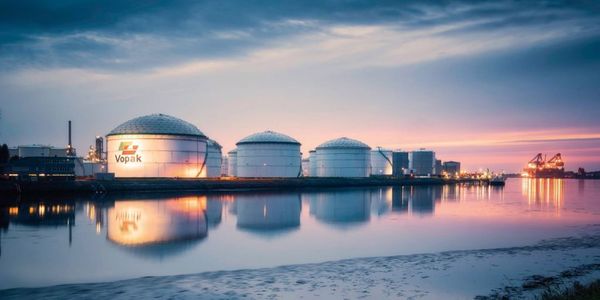HyNL project to supply e-methanol to Dutch and German areas
A 100 MW electrolyser facility is expected to be operational in three years and cater to Dutch industrial demand, before being expanded to 1.85 GW capacity by 2030.
 PHOTO: Vopak terminals store a range of energy products, spanning oils, gases, biofuels - and next: hydrogen and ammonia. Gasunie
PHOTO: Vopak terminals store a range of energy products, spanning oils, gases, biofuels - and next: hydrogen and ammonia. Gasunie
The HyNetherlands (HyNL) project sets out to build and eventually operate a major e-methanol supply chain in the Netherlands and northern Germany.
E-methanol will be produced through combining green hydrogen and biogenic carbon dioxide at three production plants in the Dutch Groningen province.
"Methanol is one of the most effective green hydrogen carriers and will be key to the development of the hydrogen economy in the Netherlands and Europe," says OCI's chief Ahmed El-Hoshy.
Chemical products producer OCI is one of three partners in the project, along with renewable energy producers Engie and EEW. The trio looks to secure a grant from the EU’s Innovation Fund to fund the project.
Engies' green hydrogen production plant will be situated in Eemshaven and have a 100 MW electrolyser powered by offshore wind.
Green hydrogen has zero carbon emissions as it is produced through electrolysis of water using renewable energy sources like wind, solar and hydropower.
An already established waste-to-energy plant in nearby Farmsum will connected to the EEW's upcoming carbon capture plant, which will capture biogenic carbon dioxide from flue gases emanating from the existing plant.
The hydrogen produced at the Eemshaven plant will then be combined with the biogenic carbon dioxide from the Farmsum plant at OCI's BioMCN e-methanol plant, which is also in Farmsum.
These three production plants will then be connected to Gasunie's hydrogen pipeline network to supply e-methanol to Dutch and northern German areas. These pipelines are mostly used for natural gas flows today.
The firms claim hydrogen and e-methanol can easily be transported through existing infrastructure and bunkered by ships.
Hydrogen production capacity is believed to be vital to achieve the EU’s net zero-emission targets by 2050. Major ports and companies have already announced plans to create hydrogen supply chain networks.
Gasunie is in the process of ramping up hydrogen import infrastructure in northern Europe and recently announced a partnership with terminal operator Vopak to build hydrogen import terminals in Dutch and German ports by 2025.





